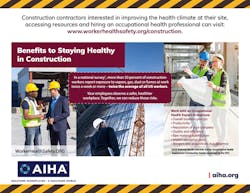Free resources from AIHA educate construction industry leaders about the health risks associated with construction work.
AIHA is an association for occupational health and safety science professionals, including industrial hygienists who work alongside construction safety experts to reduce health risks to workers and organizations. According to a study cited by AIHA, more than 50 percent of construction workers report exposure to vapors, gas, dust, or fumes at work twice a week or more—twice the average of all US workers.
The free resource is a guidance document—Focus Four for Health, an Initiative to Address Four Major Construction Health Hazards—that provides straightforward, practical ways for construction employers to identify and control these hazards, according to AIHA. The document was developed by the AIHA Construction Committee.
“Efforts to reduce health hazards typically lag behind those for safety hazards on many construction worksites,” said Janet L. Keyes, chair of the Construction Committee and principal at Chess, Inc. “Safety gets more attention because injuries and safety hazards are easier to recognize. If an injury occurs, it typically happens right on the site. Health hazards tend to be much less observable and can be even more damaging to a person and the organization.”
Construction-related health hazards include noise, heat, air contaminants, and manual material handling.
AIHA construction health hazards
Noise induced hearing loss is the most common work-related illness in the US. While it does not lead to death, it causes problems communicating, which can contribute to increased risk of accidents and injuries. It also causes permanent damage to the quality of life.
Heat can kill. People doing heavy labor in the summer often do not notice that they are suffering heat stroke or exhaustion until they collapse.
Breathing in air contaminants such as dusts, fumes, and vapors can cause long-term damage to the lungs, nervous system, and other organs.
The physically demanding work of many construction tasks push workers beyond their bodies’ natural capacity, damaging soft tissues, muscles, and tendons. Over time, that can lead to chronic pain and lifelong problems, including limiting the ability to work.
Occupational health professionals (industrial hygienists) can evaluate exposures to help determine if an organization needs to be concerned about exposures to health risks, including noise and air contaminants such as welding fumes or solvent vapor, according to AIHA. They can assess exposure to harmful chemical, biological, physical, and ergonomic hazards; advise on training and the use of personal protective equipment; and provide practical recommendations to reduce exposure to construction health risks.
Source: AIHA





